The unlikely sequence of discovery that turned a cheese-making innovation in Denmark into a precise tool for genome-editing that has swept through biomedical laboratories around the world was the subject of the annual Massry Prize lecture on Oct. 29.
“Few discoveries transform a discipline overnight,” said Elizabeth Fini, PhD, director of the Institute for Genetic Medicine at the Keck School of Medicine of USC, during her introduction of two of the three winners of this year’s Meira and Shaul G. Massry Prize. “But biologists can manipulate cells in ways never possible before” thanks to a discovery about the bacterial immune system referred to as CRISPR (clustered regularly interspaced short palindromic repeats).
The technology developed from efforts led by one of the Massry Prize recipients, Philippe Horvath, PhD, a senior scientist at the Denmark-based food company Danisco (later acquired by DuPont). He told a capacity crowd in Mayer Auditorium about the origins of his team’s research — studying bacteria in order to protect the integrity of Danisco’s starter cultures, which are integral in the production of cheese, yogurt and other foods.
What Horvath discovered is that bacteria are capable of defending themselves against repeated infections by viruses known as bacteriophages, which are commonly found in milk and other raw food materials.
“Because the fermentations are done in conditions that are not sterile, phages may be able to propagate in production settings,” Horvath said about the problem he was trying to solve. “If the level of phages reaches a high value, it can have a very severe impact on fermentation, which can lead to a total fermentation failure.”
The breakthrough? Exposing bacteria to bacteriophages actually made them immune to future attacks, and Horvath and his team deduced that CRISPR sequences held the key. Then they mapped out a method to protect their prized cultures.
Enter Emmanuelle Charpentier, PhD, the director of the Max Plank Institute for Infection Biology in Berlin. She and the third Massry Prize recipient, Jennifer Doudna, PhD, built on Horvath’s research by figuring out that two pieces of RNA join with protein made by the bacteria, called Cas9, to cut the DNA at a specific spot. And they realized this mechanism could be used for more than just combating bacterial viruses — it could be used to edit genomes.
“Research on bacteria has led to the identification of a large number of enzymes that have been extremely useful in molecular biology and genetics,” Charpentier told the audience. “CRISPR-Cas9 is a tool that is quite easy to harness for precise genetic surgery
… in any cell or organism.”
The lecture by Horvath and Charpentier preceded an awards ceremony that took place two days later in Beverly Hills, and it will be followed by a trip to USC for Doudna, professor of chemistry and cell biology at UC Berkeley, who will continue the story of this landmark research during a presentation at the Keck School of Medicine in December.
The Meira and Shaul G. Massry Foundation founded the international Massry Prize in 1996 to recognize contributions to the biomedical sciences and the advancement of health. Shaul Massry, MD, is professor emeritus of medicine at the Keck School. The foundation promotes education and research in nephrology, physiology and related fields.
— Amanda Busick


